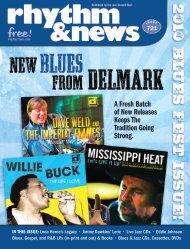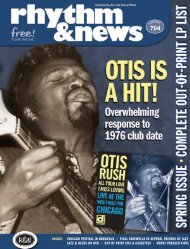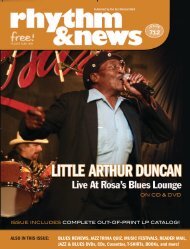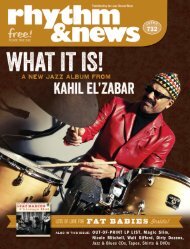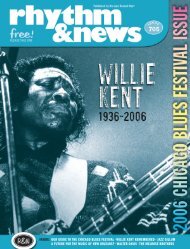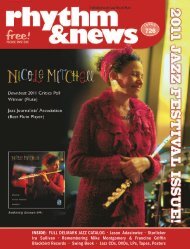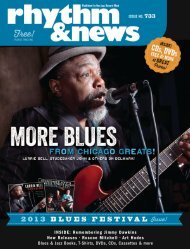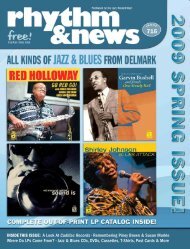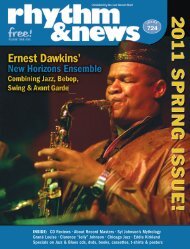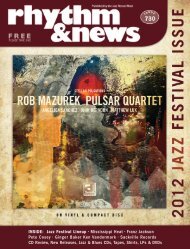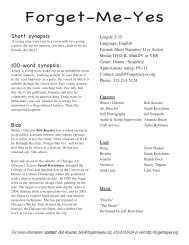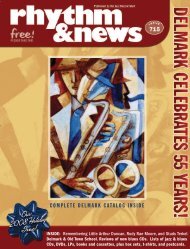ALSO IN THIS ISSUE: Judi K On The Life Of A ... - Delmark Records
ALSO IN THIS ISSUE: Judi K On The Life Of A ... - Delmark Records
ALSO IN THIS ISSUE: Judi K On The Life Of A ... - Delmark Records
- No tags were found...
You also want an ePaper? Increase the reach of your titles
YUMPU automatically turns print PDFs into web optimized ePapers that Google loves.
Speaking of Traditional Jazz..Traditional Jazz, Dixieland, Classic Jazz. <strong>The</strong> many faces ofjazz, especially Traditional Jazz are a vital part of our Americanheritage. This was a message that was always very important to mypartner, Jim Beebe. He was one of those champions of Dixielandand of the great trombonists and outstanding timekeepers of theera. <strong>The</strong> even tempos, the deep, swinging beat of Armstrong,Teagarden, Scobey, Beiderbeck and so many others. the list is longand important. need to be listened to by young jazz teachers andstudents really listened to. <strong>The</strong> value of hearing thosesophisticated chords and analyzing them is priceless andsomething that cannot be learned by simply reading the music, andplaying the notes. I would like to insert here, that the lyrics or storyline of the song is equally important to learning the feel, thedynamics of the song, and the manner in which it is interpreted,whether it is sung or not.Chicago is very rich in classic jazz musicians, with some of theyounger ones continuing the all-American tradition that is the basis ofevery other kind of jazz. Like abstract art, the painter has to learn thedetails of the (picture) song first, before eliminating notes and takingthe line in different angles. <strong>The</strong> goals should always be the same:coming back to the gist of the song with meaning and heartfeltresolution. It’s the older and more seasoned players who have thatrichness of evaluating what the older greats did with the chords andphrasing. <strong>On</strong>e of Chicago’s greatest examples that I can say I washonored to learn from was the wondrous Franz Jackson, who wasvery generous with his offerings of stage knowledge and performance,and enjoyed keeping me in line, along with anyone else who wasworking with him. And, of course, our very own Barrett Deems, themaster timekeeper, who could make anything swing, and who alsowas a generous heart with me when he was around. <strong>The</strong>re was TruckParham, who was with Jim’s band a long time, forever teaching byexample and one day giving me his picture thanking me (!) for the rideon my shooting star; there was the great Duke Groner and RoselleClaxton, all whom were devoted to displaying professionalism Icouldn’t have gotten from anywhere else. Beebe was a catalyst forthe movement of encouraging new talent. When he recognized anewer talent, such as Paul Asaro, he would take him under his wingand these lucky performers got the feel of working with a band, versusplaying solo. Pianists would learn to use the section of the keyboardthat would least likely get in the way of soloists, and we would alllearn the various key pitfalls of the horn’s ranges. And, we all woundup with huge repertoires as a result, along with a sense of humility.I have never in my life, before or since, enjoyed the generosity ofplayers as I did with the biggest names around the Chicago area.With my heartfelt thanks to Franz Jackson, Jim Beebe, Sonny Turner,Truck Parham, Roselle Claxton, Barrett Deems, Jimmy Johnson andmany others, I appreciate the experience of learning from them all.You are forever in my heart.At Dick’s Last Resort.With my first experience at <strong>Delmark</strong>, I was in awe of the volumesof musicians who frequented the studios there. A walk through thehallway provides several interesting pictures of recording groups, andwith my returns to <strong>Delmark</strong> to record, I still marvel when I get to seethe many fabulous players who have graced the studio and the<strong>Delmark</strong> label.I would hope that in this day of the computers and doctoringrecordings, that the talent’s of the jazz and blues performers will stilluse live recording studios to preserve the music. Especially Classicjazz. It wasn’t written for robots; it was written for our hearts and foodfor our souls. Some of the best recordings came out of a room withonly one microphone and everyone playing live. Clams and all. Someof the best vocals did too. I think it’s a big mistake to let the realstudios wane.I would hope that these days, when venues are a bit scarce, thatthe musicians in the know will continue to be generous to the youngsoon-to-bepros entering the world of performing jazz. While theshooting star of Eric Schneider and Bobby Lewis sail across the skies,they know where their beginnings were. Classic jazz - or TraditionalJazz. <strong>The</strong> Chicago area continues to support a few jazz radio stationssuch as WRRG, and should be proud of it! And the Chicago areacontinues to spawn professionals such as Yves Francois, a trumpeterwho, despite his youth, knows every traditional tune and then some,and he plays them with gusto.With the overtones of Dixieland, Gospel, Chants, the rhythms ofthe railroad workers, the engines and sledgehammers keeping time tothe creations of melodies sung by the workers and expanded into thegreat talents that followed is not something to be pushed to the backburners of musical history.<strong>Judi</strong> K & Truck Parham- <strong>Judi</strong> Ksinger, featurewriter for theMississippi Rag,SpecialCorrespondent,Lee Newspapers,Published series:Arcadia NewsLeaderwww.judikjazz.com11



